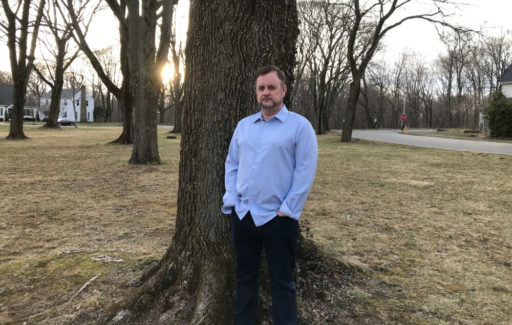We recently spoke with author Tom Noyes about his new Slant book, The Substance of Things Hoped For
What experiences and influences shaped you as a writer?
Even as a kid, I remember reading stories and being enamored not only by the characters, plots, and settings but also by the notion that there was a personal presence behind the telling, that someone out there, some author, had first imagined into being what I as the reader was now imagining into being.
As much as I loved reading, this idea of being the first imaginer was something that I always aspired to, and I was lucky as a young writer to have had many good teachers—from elementary school all the way up through my graduate programs—who cultivated this aspiration.
I was lucky, too, that I was never made to feel that I was taking fiction writing too seriously or that I needed to focus on more “practical” endeavors. No one ever told me that I needed to put fiction writing in its “proper place” as a hobby rather than making it my vocation. At least, no one told me this until it was too late! I feel very blessed by the support I enjoyed as a fledgling writer.
How did you come to the subject matter for The Substance of Things Hoped For? What originally piqued your interest in John Humphrey Noyes’s Oneida Community?
As is readily apparent, John Humphrey and I share a surname, and I was always aware of him lurking there. I think I knew, ever since I started to write seriously, that I was on a collision course with this novel. I also knew there would be significant research necessary—this is probably what held me off for all those years—but when I got the opportunity to immerse myself in it, the research became addictive.
Noyes himself was such a conflicted personality, a man of such extremes, that I soon realized that I would need help in figuring him out, and that’s when I started meeting the other citizens of his community. In discovering them through their diaries and memoirs, as well as in my own pages as I watched them begin to connect and conflict with Noyes and each other, I thought I might be onto something.
Also, I visited the Oneida Mansion House and Museum on a couple occasions. I spent a few nights in one of the mansion house rooms, worked on the novel for a few days in the restored mansion house library, roamed around the grounds, hiked around the lake, was stung by a bee outside John Humphrey Noyes’s bedroom, even dozed off for a few minutes in this gazebo-like structure Oneidans called the Summer House. I don’t consider myself a superstitious writer, but I can’t deny these visits helped prepare me, in a kind of spiritual, uncanny way, for the writing I had to do, the voices I needed to access.
And then the character of Charles Guiteau showed up and transformed the project completely. The more I read about him before, during, and after his stint with the Oneidans—his arc from would-be Perfectionist to presidential assassin—the more I realized this wasn’t only John Humphrey Noyes’s book, this was going to have to be Charles Guiteau’s book, too.
One thing the novel seems to want to encourage the reader to do is compare and contrast Guiteau and Noyes. Could you talk a bit about how you see this connection?
Guiteau is ill. His madness is dark and sad and hopeless. His life is full of pain, and he projects this pain onto others, which drives them away. As a result, loneliness becomes a part of his pain. In a sense, he can’t help what he becomes. Noyes is very different. He suffers from delusion, for sure, but he’s also charismatic, smart, and passionate. People are drawn to him. Many of his followers are hurt by him, but many are helped, too. He’s more self-aware than Guiteau, for sure, and he’s skilled at reading and manipulating people. These differences aside, though, what links the two men is their conviction that they have been chosen for divine purposes, that they are God’s vehicles. This belief affords both of them a sort of tragic, doomed quality. History and literature suggest that prophets, whether legitimate or not, whether genuine or false, often don’t enjoy happy, graceful endings. It’s not an easy gig.
The Guiteau sections in the novel—Charles’s chapters, especially, but his mother’s and his sister’s, too—are told in voices marked by idiosyncratic syntax and repetition. How is this stylistic aspect of the novel important to the way you see Guiteau’s character?
In these sections, the voice has the tendency to work its way backward before it allows itself to moves forward. A mind echoing its own thoughts. I think I hear Guiteau in this way for two reasons. First, I think repetition can be comforting. Guiteau doesn’t have many sources for comfort in his life, and I think the repetitive voice shows Guiteau relying on his own broken mind for respite. Even though this inclination of his provides opportunity for some comedic moments here and there, I think it’s desperate and sad, too. Secondly, in some passages, I think the repetitive nature of the narrative voice functions to reflect Guiteau’s obsessiveness. A mind constantly, needlessly reminding itself to remind itself of what it never forgets. What it could never forget even if it wanted to.
Could you speak to the significance of the novel’s title?
The phrase comes from the book of Hebrews. “Now faith is the substance of things hoped for, the evidence of things not seen.” I think the Oneida Community itself can be considered in light of this notion of faith as aspiration. Noyes and his followers wanted it to be a flesh-and-blood ushering in of God’s divine kingdom. The community mansion they built, the children’s house, the factories, the gardens. Oneida embodied their faith, not only in God, but in themselves, in the potential of humankind, in Noyes himself.
What aspects of their faith were misplaced? What aspects were naive? How did their faith benefit them? How did it harm or undermine them? Faith is risky. Hope is risky.
Do you see elements of this novel set in the nineteenth century as being timely? How do the themes and characters of the novel speak to the twenty-first century?
I think some of the themes and questions that emerge in the novel translate pretty easily to our world today. The tension between individual freedom and responsibility to community informs both the novel and our current social climate. Also, the notion of faith as not only belief but as responsibility resonates today. It matters what voices one listens to. It matters where those voices are coming from and what forces are motivating them.
I think the inherent danger of delusional leadership is a fairly timeless theme, too. Words have the power to illuminate, clarify, and edify, but, of course, they can also mislead, obfuscate, and incite. This isn’t a new truth, of course, but it seems today to be newly, urgently evident.
Since writing the novel, I’ve imagined how John Humphrey Noyes and Charles Guiteau might have negotiated Twitter or Facebook. How many followers they might have attracted. How many likes they might have earned. How many of their tweets and posts might have been tagged for violating the rules. I can’t decide if they’d be social media stars or pariahs. Maybe there’s not much of a difference in some cases.
Tom Noyes is the author of three story collections, including Come by Here: A Novella and Stories, winner of the Autumn House Prize in Fiction and The Independent Press Awards’ Gold Medal in Short Fiction. He directs the BFA in Creative Writing Program at Penn State Erie, The Behrend College and serves as Contributing Editor for the literary journal Lake Effect.





